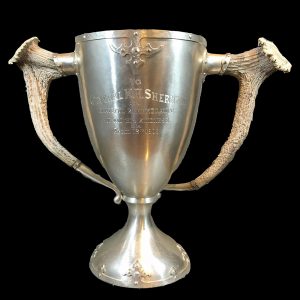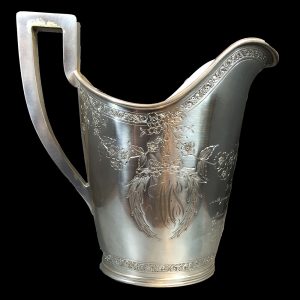Today, in a world addicted to 24/7 news, an earthquake shaking Italy is broadcast worldwide just minutes after it happens. Relief is on its way shortly thereafter. It wasn’t quite that way on Wednesday April 18, 1906 when a violent earthquake shook San Francisco apart. The earth rocked and rolled for 40 seconds and when it settled every line of communication but two within the city and connecting it to the outside world had been destroyed. (A single line to New York and an underwater cable connection to India were all that remained.) For all practical purposes the shattered city was totally cut off from the world and the help it desperately needed.
The earthquake struck at 5:12 a.m. and while the Richter Scale did not yet exist the best guess is that the quake was at least an 8.25 magnitude shaker. It was obvious that this was one of the most powerful quakes ever recorded. The City Hall crashed down, buildings new and old crumbled to rubble, the Fire Chief was fatally injured and many others were killed outright—the ultimate toll is estimated at over 3,000 dead. Injured and terrified residents spilled into the streets and parks looking for shelter. In a city of 450,000 people over half were suddenly homeless, thirsty, and hungry. The water mains broke destroying the water system. Fires broke out almost immediately adding another layer of horror to an already horrific morning.
One of the first critical tasks was to restore communication to the rest of the country and summon aid. Sometime between 7 a.m. and 10 a.m. the Army Signal Corps was able to reestablish some telegraph lines and began to send out news of the devastation. By mid-morning Los Angeles received the news of San Francisco’s plight and by noon the word had spread across the city. (There are varying reports of the earthquake being felt as far south as Los Angeles and San Diego. If so it probably was considered just a small tremblor.)
In 1906, San Francisco was the premier city in California already known for its sophistication and power. Los Angeles by contrast was considered a brash backwater. However, many business men spent time in both cities and many Anglenos had family and friends in San Francisco. That morning the California Supreme Court justices were holding court in Los Angeles. Their wives and children were in San Francisco. Gen. Moses H. Sherman’s (who owned the trolley cars rapidly stitching Los Angeles together) wife, daughters, and nieces were in San Francisco and many others were in the same position. There was no way to determine their well-being.
The justices immediately cancelled court and started looking for a way to get to San Francisco. Pandemonium had overtaken the railroads as they were the only possible way to reach the stricken city quickly. Long lines of people were demanding tickets and the Southern Pacific and Santa Fe were scrambling to add as many cars as they could to each scheduled train. Sleeping compartments and every available seat were quickly sold. The justices missed the first train north and started looking for a Special train. However, the situation with the tracks was totally unknown and the railroad decided not to send the Special train.
Gen. Sherman was known for his forceful personality as well as his streetcars, and he lived up to his reputation that day. In short order the city fathers had organized a Supply Committee and by afternoon they had assembled 14 rail cars of supplies and another nine carloads to go by ship from San Pedro. Gen Sherman used his contacts with the Southern Pacific to charter a train, loaded the Supreme Court justices, doctors, and other Angelenos who needed to find their loved ones along with the supplies and started north. In all 28 people accompanied Sherman on his rush north.
Besides the judges, the group included Gen. H. G. Otis, Harry Chandler (Los Angeles Times), E.P. Clark, R.P. Sherman (Sherman’s brother in law and son), R. C. Gillis (Santa Monica Land & Water Company,) the Attorney General, Secretary of State, and other prominent Angelenos. The train had no dispatcher. There was no way of knowing the state of the track—was it damaged or intact—officially the line was closed. There were wild rumors of bridges being out and tunnels falling in. There was no way to know what was happening in San Francisco. Each stop on the run through the San Joaquin Valley yielded wild rumors such as, “Chicago had sunk into Lake Michigan” and “The whole of Long Island swallowed by the sea.” Running through the night, the train reached Oakland Thursday morning in record time. It was the first outside relief to reach the crumbled and burning city.
The men and women were expecting the worst looking at the inferno the city had become from the pier in Oakland. However, the ferry was waiting to take them across the bay, and they were able to begin their search for their loved ones. Finding a lumber wagon they hitched a ride to Van Ness Avenue and spread out toward their homes. Sherman found his wife and daughters at their home which was so far untouched. They were frantic with worry since it was rumored that Los Angeles had sunk into the sea.
Fortunately, all the men and women who made the wild ride north with Sherman to San Francisco found their families and friends had survived the quake although many had lost their homes.
At a banquet held a year later on the anniversary of that frantic trip north the men who make the trip reminisced about their experiences and praised Gen. Sherman for his efforts to help San Francisco and to find their loved ones. As a token of their appreciation for his efforts a silver pitcher and a silver presentation cup were inscribed with their names and presented to Gen. Sherman. Pictured below they are now part of the Sherman Library Archives located in Corona Del Mar.
 The silver cup presented to Gen. Sherman has distinctive antler handles and is inscribed on the front of the cup. “To General M.H. Sherman in Grateful Remembrance of all his kindness on April 18th 1906.” The back of the cup has the signatures of the California Supreme Court judges that went north on Sherman’s relief train. B. McFarland [Thomas B. McFarland], William H. Beatty, Frederick W. Henshaw, Frank M. Angellotti, Lucian Shaw, G. Lorigan [William G. Lorigan], and M.C. Sloss
The silver cup presented to Gen. Sherman has distinctive antler handles and is inscribed on the front of the cup. “To General M.H. Sherman in Grateful Remembrance of all his kindness on April 18th 1906.” The back of the cup has the signatures of the California Supreme Court judges that went north on Sherman’s relief train. B. McFarland [Thomas B. McFarland], William H. Beatty, Frederick W. Henshaw, Frank M. Angellotti, Lucian Shaw, G. Lorigan [William G. Lorigan], and M.C. Sloss

The pitcher is inscribed with a similar presentation and the names of the others who made the trip to San Francisco on the relief train. “To General M.H. Sherman with Grateful Remembrance of all his kindness April 18th 1906.” Maria A. Wilcox, Mary W. Longstreet, Caroline M. Hicks, Elizabeth C. Hicks, John J. Gaffey, Harry M. Gorham, R. C. Gillis, Alfred H. Wilcox, Frank S. Hicks
(Photos courtesy of the Sherman Library and Garden, Corona del Mar, CA)